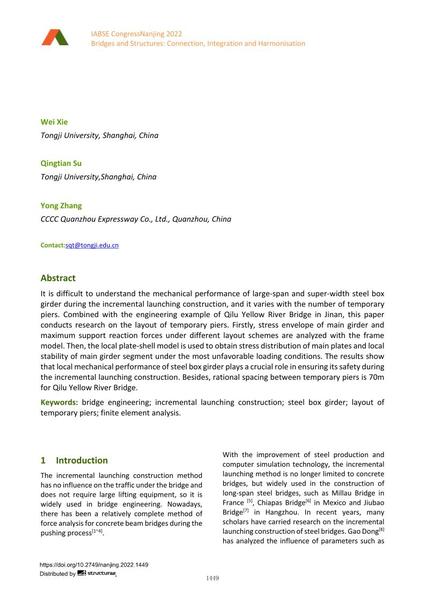Research on the Layout of Temporary Piers of Large-span and Super- Width Steel Box Girder during Incremental Launching Construction

|
|
|||||||||||
Détails bibliographiques
| Auteur(s): |
Wei Xie
(Tongji University, Shanghai, China)
Qingtian Su (Tongji University,Shanghai, China) Yong Zhang (CCCC Quanzhou Expressway Co., Ltd., Quanzhou, China) |
||||
|---|---|---|---|---|---|
| Médium: | papier de conférence | ||||
| Langue(s): | anglais | ||||
| Conférence: | IABSE Congress: Bridges and Structures: Connection, Integration and Harmonisation, Nanjing, People's Republic of China, 21-23 September 2022 | ||||
| Publié dans: | IABSE Congress Nanjing 2022 | ||||
|
|||||
| Page(s): | 1449-1456 | ||||
| Nombre total de pages (du PDF): | 8 | ||||
| DOI: | 10.2749/nanjing.2022.1449 | ||||
| Abstrait: |
It is difficult to understand the mechanical performance of large-span and super-width steel box girder during the incremental launching construction, and it varies with the number of temporary piers. Combined with the engineering example of Qilu Yellow River Bridge in Jinan, this paper conducts research on the layout of temporary piers. Firstly, stress envelope of main girder and maximum support reaction forces under different layout schemes are analyzed with the frame model. Then, the local plate-shell model is used to obtain stress distribution of main plates and local stability of main girder segment under the most unfavorable loading conditions. The results show that local mechanical performance of steel box girder plays a crucial role in ensuring its safety during the incremental launching construction. Besides, rational spacing between temporary piers is 70m for Qilu Yellow River Bridge. |
||||
| Copyright: | © 2022 International Association for Bridge and Structural Engineering (IABSE) | ||||
| License: | Cette oeuvre ne peut être utilisée sans la permission de l'auteur ou détenteur des droits. |
||||
